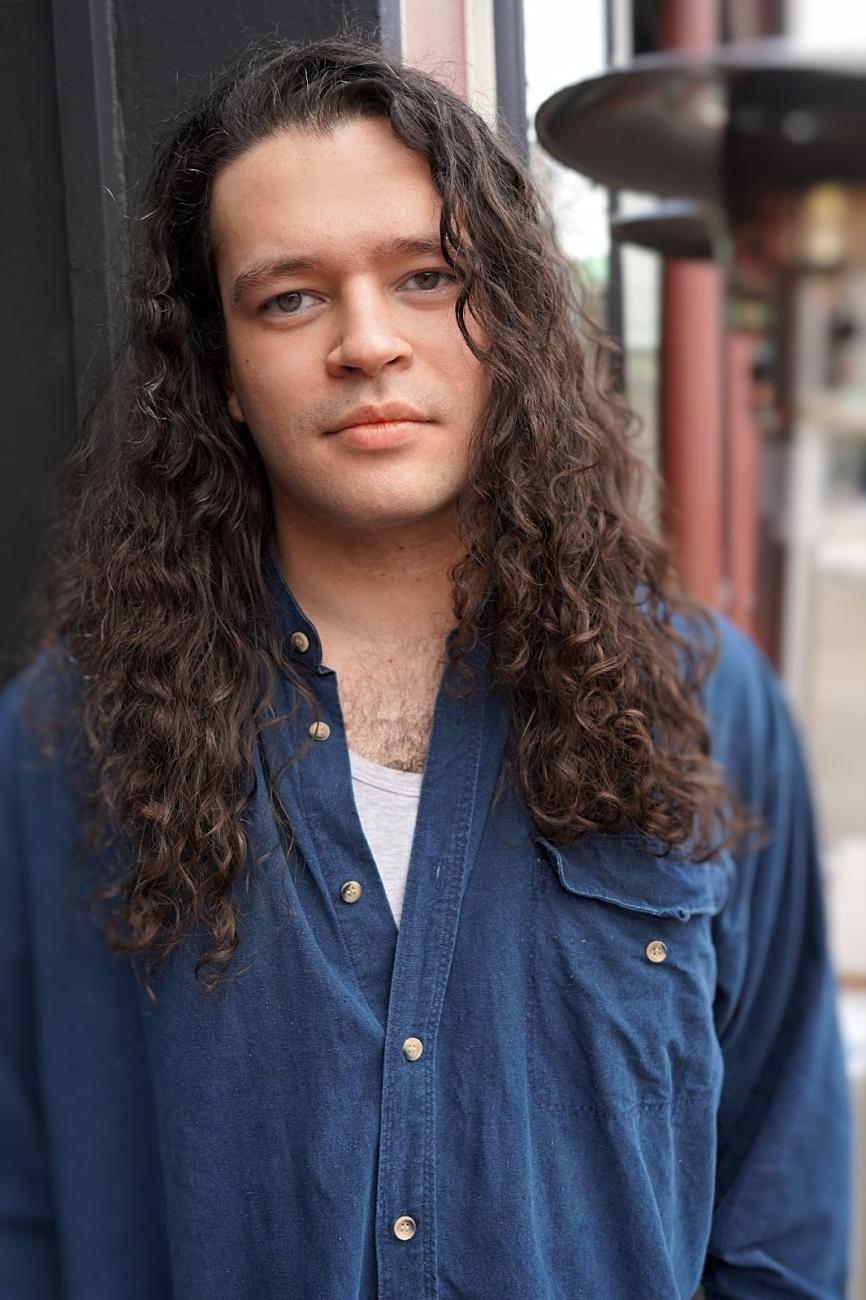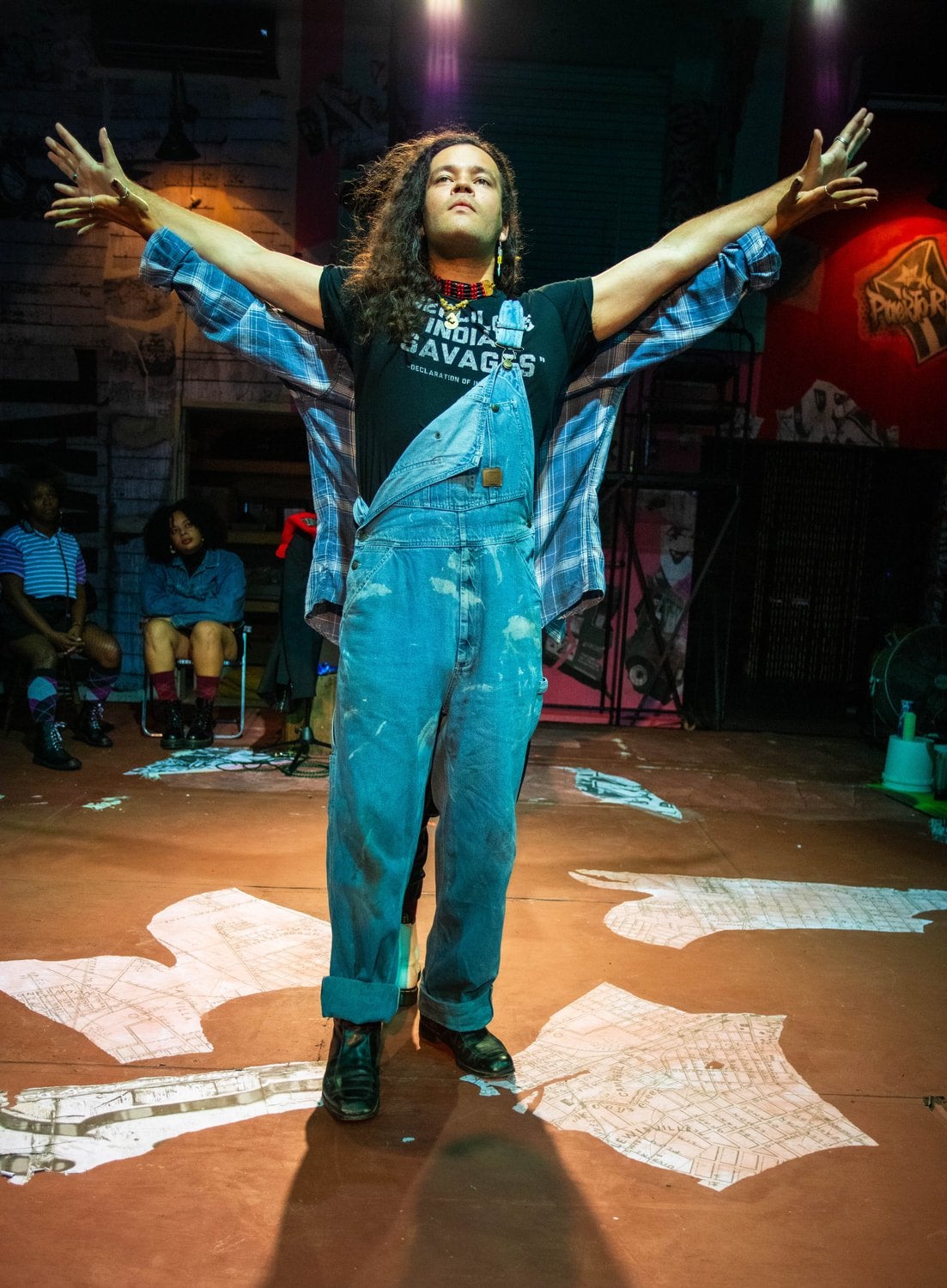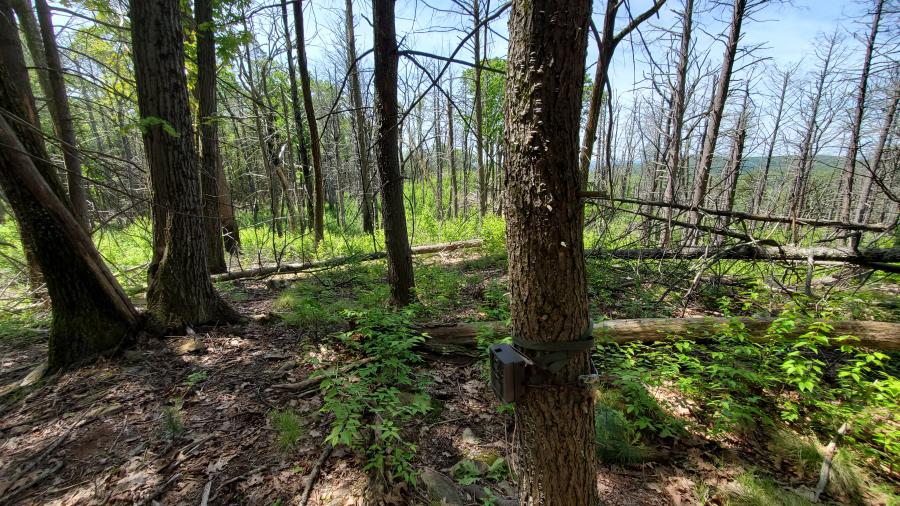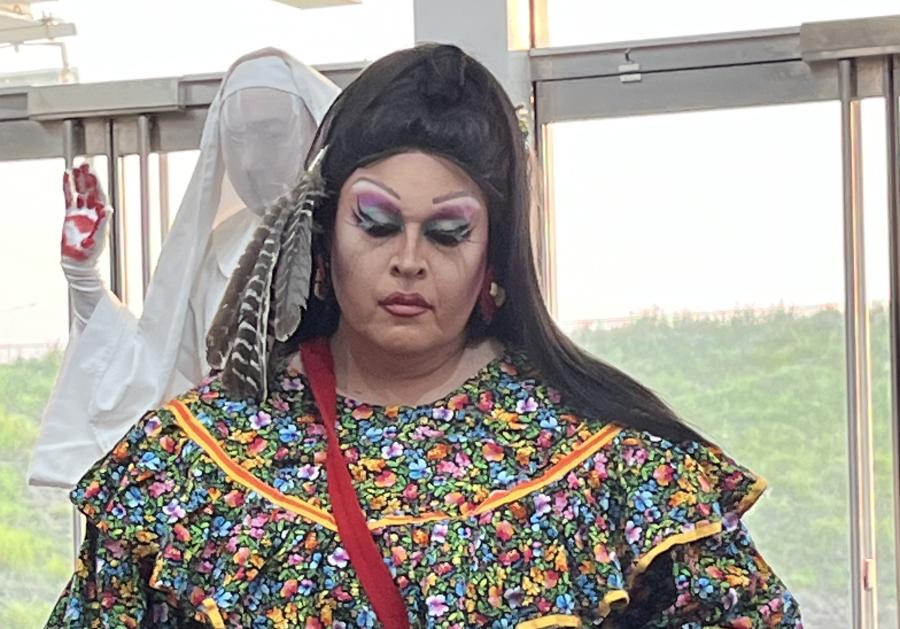
By Tia-Alexi Roberts (Narragansett, CS staff)
June marks Pride Month, a time to honor the contributions, visibility, and resilience of 2SLGBTQ+ communities. As over 11 million U.S. adults now openly identify as LGBTQ+, increased representation has brought both celebration and scrutiny, especially as public institutions and corporations navigate how to engage authentically with these communities. For Indigenous Queer and Two-Spirit individuals, this visibility is further layered by histories of erasure, land dispossession, and cultural resistance, especially in creative spaces.
Chingwe Padraig Sullivan (she/they/he/nákum) is a Two-Spirit Indigenous actor from the Shinnecock and Montaukett Nations, currently based in New England. Raised in Boston, Sullivan brings a vital lens to their work, highlighting how Indigenous identities are often excluded from dominant narratives of place and performance. After studying at the Brown/Trinity Rep MFA Acting Program, where they portrayed Adam and Leo in “The Inheritance,” Sullivan chose to leave the program in pursuit of work more deeply rooted in Indigeneity. This led to a breakout role as Levi in the world premiere of “Cashed Out” at the San Francisco Playhouse.
Sullivan’s body of work includes the short film “Emerald Bay,” a collaboration with the renowned Spiderwoman Theater on “Misdemeanor Dream,” and core ensemble work with Safe Harbors NYC’s “Feast of Ghosts.” Most recently, Sullivan appeared on Boston stages in “Haunted” with Company One and “Sugar” with Fresh Ink.
Cultural Survival recently spoke with Sullivan, who reflected on the intersections of art, identity, and activism and the ongoing work of reclaiming space for Indigenous and Two-Spirit narratives in contemporary theater.
Cultural Survival: Can you share a bit about your background—where you’re from and how your culture and community have shaped who you are?
Chingwe Padraig Sullivan: I’m Shinnecock and Montaukett from Long Island, but I grew up in Boston. A lot of my community growing up came from going to a summer camp called NAYEP (the Native American Youth Enrichment Program), which for a long time met at NAICOB (the North American Indian Center of Boston), which was really cool because I didn’t realize until I was an adult how much important history that building is tied to. But that gave me a lot to hold onto as a kid. We were existing as a community of Native kids, growing up together in a city that really doesn’t like to acknowledge we exist. Boston especially is so, so, so white, and the identity of the city is so tied to the American Revolution and that particular kind of early colonialism, that outside of summer camp, where I was surrounded by other Native kids and Native instructors, my only direct Native community was my mother. We’d see my cousins when we’d go back to Long Island for powwow or just to catch up, but that wasn’t as common as any of us would’ve liked. A core part of who I am is tied to existing in places like Boston and going, “No, Indigenous people aren’t extinct. No, Thanksgiving didn’t happen like that. Yes, I live in a modern house with electricity and flowing water.” So for me, being Indigenous has meant existing in resistance every single day for as long as I can remember.

Photo by Erin X. Smithers.
CS: When did you first come to understand or identify as Two-Spirit, and how has that identity evolved for you over time?
CPS: I’ve known I was some form of Queer since late high school/early college, but it wasn’t until Covid lockdown that I had time to really sit down and sort out who I felt I was. I remember I was sitting with my then-partner and we were on the phone with a very old friend of mine, talking about our own journeys with queerness and gender identity. For some reason we were Googling the specific definitions of terms, and we read the definition of “cis,” which means you identify only with the gender you were assigned at birth. My partner and I had simultaneous reactions of going, “only?” Which is the moment I realized I wasn’t just a man. That’s when I really pivoted from defining myself by pre-existing labels, and instead found the traditional understandings that represented who I felt I was, and who I felt I was becoming.
Of course, part of the difficulty of coming from a Nation that was hit hard by colonization all the way back in the 1600s is that a lot of those traditional genders that weren’t just male or female, or resembled what we understand as being Trans today, were hit by erasure so long ago that it’s hard to even find what our traditional terminology was. So I’ve embraced Two-Spirit as the umbrella term it was meant to be when it was created in the ‘90s. For me, it means that I exist mostly in my personal life and with my friends and family and in certain traditional and cultural spaces as a woman, but I exist in a lot of professional spaces and different traditional and cultural spaces as a man. And that’s also changing for me over time. These days I exist in more and more spaces as a woman, and I think that’s also one of the beautiful things about being Two-Spirit: it’s not a static existence for me, it’s one that inherently embraces the change and growth of life. I’m not the same person I was when I first realized I wasn’t “just” a man, and that’s the point.

Photo by Aaron C. Packard.
CS: Did you see yourself reflected in the media or on stage growing up? How did that shape your path?
CPS: I did and I didn’t. Growing up in New England, a lot of the Native representation I saw was stuff like PBS documentaries about “the first Thanksgiving” and Jamestown—a lot of stuff that relegated us to a very specific time in the past, to very specific rules of who we were and weren’t allowed to be. I think the one Native actor I saw growing up outside of the classics like “Smoke Signals” and "Dances with Wolves" was in “The Indian in the Cupboard.” I don’t think there were any Native actors on stage in Boston, at least none that I knew of growing up. It was simultaneously depressing and really a kind of opportunity, because while there was no one like me who had a path I could follow, it meant I could forge my own.
Now, though, I’m so happy to see and know so many other Indigenous actors. I’m so lucky to be working with a lot of people who are all forging these same paths for ourselves, who get to be Native on stage and on camera and define what that means for ourselves. And I’ve been lucky enough to work with Native theater companies like Spiderwoman Theater, which was founded by powerful Native women in the ‘70s [who] have been doing this work all that time, and are still fighting that same battle.
CS: How did you break into the acting world, and what were some of the biggest challenges you faced early on?
CPS: I wish I could pin down one specific moment that I “broke in”—it’d make such a dynamic story. But the truth is, you have to break in many many times in your career. I think the closest to a classic big break is when I auditioned to get into grad school for acting and actually got in. That felt like a moment where the industry and institutions really recognized that I had something valuable as a Native performer. The challenge after that was holding onto what made me special. Grad school was several years of intensive, focused work, and a lot of that was focused on turning me into a specific kind of actor. It assumed that I thought of storytelling and community and a lot of other stuff in a very specific, colonial way. And so when I disagreed on those things, I had to fight with the institution for it to see what I brought with me as valuable. It turns out they didn’t want an equal exchange of learning, them teaching me how to be a better actor, me teaching them how to tell stories that don’t follow colonial storytelling techniques, that don’t treat characters or audiences the same way. Instead, what they wanted was to be able to put me in a box of their choosing so they could say, “We have a Native actor, and they are good because we made them good.” So while the recognition of breaking in was great, it led to several years of fighting with an institution that should’ve been supporting me.
CS: Have you ever felt pressured to hide, downplay, or modify your identity in order to fit into casting expectations or roles?
CPS: Of course. Every time I audition for someone new, in the back of my head I’m trying to suss out what they think a Native actor looks like and whether I should try and play into that to get the job so that I can change that later, or I should go in right off bat, completely openly and unapologetically who I am. And if they’re not Native, I know there’s a very small chance they’ve even heard the phrase Two-Spirit, so I’m dreading the moment I have to do both ‘Native 101’ and ‘Two-Spirit 101’ for a whole group of strangers.
Usually, these days, the answer is to go in unapologetically myself. But yes, in grad school, in college, in my career between both of those, I’ve felt strongly that I have to shape myself into what people want me to be in order to get work. That’s one of the downsides of the casting process inherent to theater/TV/film—people are looking to fulfill a vision they already have in their head, and you have to either meet that vision or work really hard to convince them that the truth you represent is better.
CS: Are there roles or projects you actively seek out because they align with your values or reflect your identity more truthfully?
CPS: Oh, absolutely. There’s been a small explosion in Native theater in the past decade, and while there’s still not enough roles to go around for everyone, the kinds of roles that exist when they’re written by Natives and for Natives are so far beyond the stereotypes that exist, it’s like we’re on different planets. I spent a lot of time when I was in school and in the early years of my career playing white people and “ethnically ambiguous” roles because there weren’t many, if any, roles that looked or felt like me. And worse, the few Native roles that existed tended to be punchlines or stereotypes or were written by white people who had no business writing for us. So I had the frustrating choice of which box I wanted to force myself into to tell someone else’s story. The same goes with Two-Spirit roles. Those really didn’t exist for a long time. There are a lot of celebrated shows out there that celebrate western versions of queerness, and I’ve been in several of them, but every time, they’ve celebrated only one part of who I am, not the whole.
But now, with this explosion of Native theater, we’ve finally got Indigenous playwrights and directors writing and leading our stories and creating new ones with us front and center. And because of that, we can have different kinds of Native characters onstage with different life experiences, different cultures, different ways of being. So I suppose that’s a long way of saying yes, there are projects I actively seek out: Native-led projects. Native-written projects. Only in Native-led work have I been allowed to say, “This is who I am, from top to bottom,” and be able to do so onstage without having to explain or justify any part of me.

"Haunted". Photo by Ken Yotsukura.
CS: Is there a particular production or project you’ve been part of that stands out as a favorite? What made it especially meaningful for you?"
CPS: There’s two that come to mind right off the bat. The first is “Haunted,” a play written and directed by Tara Moses, who’s a Seminole and Mvskoke playwright and director I’ve had the honor to work with many times now. I got to play a thoroughly modern Native kid who happened to be a ghost that died in 2003 and was now haunting a white suburban home alongside his Two-Spirit sibling. The second is a workshop I just did of the play “Into Your Hands,” which is by Cree playwright Tommy Endter, in which I got to play a messy, mid-20’s Two-Spirit woman who was still figuring herself out and trying to sort through her own baggage while not adding to that of her friends. Both of these were so meaningful because they’re characters who felt like me; I didn’t have to translate myself for an outside audience. They both felt like real, modern Native people who live on the same planet I do, have the same struggles I do, who listen to the same music I do. And that is so, so rare.
CS: What does representation look like to you when it comes to Indigenous and Two-Spirit characters on screen or stage?
CPS: It looks like as many of us onstage and in front of the camera and even behind the camera as possible. It looks like to be Two-Spirit is a unique experience to everyone who is, and I’d love to live in a world where the infinity of unique experiences are given their day in the sun—their week, their month, their year in the sun. For myself, it means I get to be onstage as a man and onstage as a woman, and those two things are understood and accepted unquestioned by both the narrative and the audience there to witness it.
It’s hard to shout out specific characters that already exist onstage or on screen right now because Native representation is still so hard to find, even with the explosion of series like “Rez Dogs” and “Rutherford Falls” and “North of North.” But the more representation we get, and the more we get to represent ourselves, the more this question will be easy to answer in the future.
CS: What advice would you offer to young Indigenous or Two-Spirit people who are considering a path in acting or performance?
CPS: Be brave and be strong and carve out a path for yourself. I wish you didn’t have to, but you’ll have to work harder than so many other people do. The stereotypical idea of what it means to be Indigenous is still so pervasive, and it’s exhausting to still be fighting it in 2025. But, if you can break through, it’s so worth it. And you can break through. Anyone can be an actor. I truly mean that. And any Native kid who is living in this world already has the guts and strength and skill to make it in this industry. Never let anyone tell you who you are, and never let anyone tell you there isn’t a place for you. There is, even if you have to make it yourself. You will find community, and you will make it.
CS: What kind of change or growth would you like to see in the entertainment industry regarding Indigenous and 2SLGBTQ+ representation?
CPS: It sounds crass, but give us money! Fund our work the way Marvel movies get funded. Or at least the way every Oscar-bait biopic about some white man I’ve never heard of gets funded. There are more and more movies where there are Indigenous characters, which I’m so grateful for, but especially in the current political climate where anything that isn’t straight and white is getting defunded, I’m still waiting for the other shoe to drop. I want Native production companies. I want Two-Spirit stories to become so common I don’t have to explain it anymore. The growth I want is for our stories to no longer be treated like novelties or tokens—I want us to be mainstream and respected just like everyone else.
Top photo by Tara Moses.



